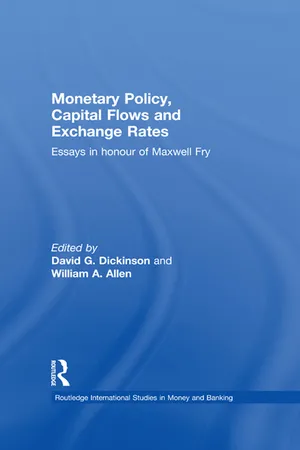Economics
Central Banking System
A central banking system is a financial institution responsible for overseeing a country's monetary policy and regulating its financial system. It typically manages a nation's currency, sets interest rates, and acts as a lender of last resort to commercial banks. Central banks also play a crucial role in maintaining economic stability and controlling inflation.
Written by Perlego with AI-assistance
Related key terms
4 Key excerpts on "Central Banking System"
- eBook - ePub
Innovation and Independence
The Reserve Bank of New Zealand
- John Singleton, Arthur Grimes, Gary Hawke, Frank Holmes(Authors)
- 2013(Publication Date)
- Auckland University Press(Publisher)
Early central banks acquired functions pragmatically rather than according to any principle. Some functions are closely interrelated. In particular, both the ‘monetary policy’ and ‘bankers’ bank’ functions often involve the operation of settlement accounts at the central bank. These tasks could be allocated to separate institutions, although there is no compelling reason for doing so. At times, a situation can arise in which the functions of the central bank could pose conflicting pressures. For example, if the central bank injects liquidity in order to avert a banking crisis, inflation might become harder to control in the short term. In general, however, monetary stability and financial stability are complementary.According to Richard Sayers, one of the historians of the Bank of England, the ‘essence of central banking is discretionary control of the monetary system’.10 The assumption on which central banking is based is that net public benefits are derived from discretionary policy interventions in the monetary and financial system. Economists, central bankers, and politicians have often disagreed about the appropriate form and degree of such intervention. (A small minority of economists have always maintained that central banks serve no purpose.) It is widely accepted that central banks should be under community control, in order to ensure that they do not use their privileges for private gain.The benefits of central banking are several. First, currency issued by a central bank is safer for the public to hold than currency issued by a private financial institution. Should the private bank collapse, its currency would become worthless. There is little chance of a central bank collapsing, because the government and the taxpayers stand behind it. The only events likely to render currency issued by a central bank worthless are hyperinflation or the disintegration of the state.Second, a central bank may be in a position to strengthen the financial system, and thus reduce the likelihood and impact of a banking crisis.11 - eBook - ePub
Financial Stability and Prudential Regulation
A Comparative Approach to the UK, US, Canada, Australia and Germany
- Alison Lui(Author)
- 2016(Publication Date)
- Routledge(Publisher)
Modern central banks are primarily occupied with monetary-policy matters (Bank for International Settlements 2009) since confidence in price stability and the currency is crucial for a healthy economy. With time, the combination of economic crises, wars and the breakdown of the gold standard transformed central banks from government banks into public agencies. This shift to a public-policy dimension meant that central banks are now working towards the interests of the financial system as a whole, rather than for commercial objectives. Like most concepts in finance, financial stability is not absolute and it changes with time. It has many facets, embracing rule-making, policy development and supervision. The lender-of-last-resort role is a way for central banks to sustain financial stability by assisting individual banks rather than monitoring liquidity for the general financial system. In exceptional circumstances such as the global financial crisis, the general liquidity and specific liquidity lending under the lender-of-last-resort principle merge. It is interesting to note that only 20 per cent of the 146 central banks have express objectives for financial stability and that around 50 per cent of the world’s central banks have more generic objectives regarding financial stability. Since the global financial crisis, the Reserve Bank of Australia, Federal Reserve, Bank of Canada, Bank of England and ECB have all had the wide objective of promoting, enhancing and contributing to financial stability. Macro-prudential regulation and supervision contribute to financial stability by involving the relevant regulatory authority in monitoring systemic risks holistically. Effective central-bank regulation is of practical importance because it can affect the quality of bank regulation and supervision (Koetter et al. 2014). The ultimate aim of macro-prudential regulation is to avoid macro-economic costs linked to financial stability (Galati and Moessner 2010) - William Allen, David Dickinson(Authors)
- 2004(Publication Date)
- Routledge(Publisher)
4 Recent Developments in Central Banking Some Special Features of the Monetary Policy Committee and of the European System of Central Banks Charles Goodhart IntroductionRegime changes are always exciting, and grist for analysis by the interested commentator. There have been several such regime changes in Central Banking during the last few years, a most exciting period for someone like myself, not only in my capacity as a professional observer of Central Banking but now also as a participant. The Chancellor’s initiatives in his first month in office in 1997, to give the Bank of England operational independence, and then subsequently to centralize all financial supervision, including the supervision of banks, in a Financial Services Authority (FSA), caused the most abrupt changes to the functions and structure of the Bank, probably since its foundation. But, of course, the extent and scale of this regime change, though in my view the most important economic developments of the incoming Labour government, have been dwarfed by the move to a single currency, the euro, with its associated European System of Central Banks (ESCB) within the euro area.There are, of course, many facets of both these institutional changes that one could discuss, and one can also undertake compare-and-contrast exercises, not only for the Bank of England and the ESCB, but also, for example, with the Bank of Japan, which has again recently undergone important institutional changes, several of which are similar to those in the UK. Indeed, there has been a veritable flood of institutional change in the last decade partly carried along on a tide of academic enthusiasm for independent Central Banks and further encouraged by the apparent success of such independent Central Bankers in achieving price stability during a decade in which world growth has, I believe, recovered somewhat from previous decades, despite Asian alarums and excursions.- eBook - ePub
- Jagdish Handa(Author)
- 2008(Publication Date)
- Routledge(Publisher)
This chapter focuses on the institutional and historical aspects of the goals, instruments and targets of monetary policy as they have been pursued by the central banks of the United States, Britain and Canada—with some material on the newly created European System of Central Banks. This material is intended to widen the discussion beyond the particularities of any one country and to provide some indication of the similarities and varieties of central bank practices in the pursuit of monetary policy.Key concepts introduced in this chapter- ♦ Central banks’ mandates
- ♦ The potential multiplicity of goals of central banks
- ♦ Open market operations
- ♦ Required reserves
- ♦ Discount/bank rate
- ♦ Credit controls
- ♦ Moral suasion
- ♦ Selective controls
- ♦ Overnight loan interest rate
- ♦ Federal Funds rate
- ♦ Administered interest rates
- ♦ Currency boards
- ♦ The competitive supply of money
Economic theory has long recognized the impact of monetary policy upon most of the important macroeconomic variables such as output, employment, growth and prices.1 Therefore, in most countries, the control of the money supply and the manipulation of interest rates, in so far as these are possible, is entrusted to the central bank rather than left to market forces.2 This chapter looks at the basic practical and institutional aspects of the goals and targets of central bank policies, and related issues such as the regulation of financial intermediaries. Institutional arrangements and practices are specified for the Federal Reserve System of the United States, the Bank of Canada, the monetary arrangements in Britain and the European System of Central Banks, which is the federated central bank for the European Union. The intention in presenting this material on several countries is to show the common elements as well as the diversity of monetary arrangements among a group of countries.Section 11.1 examines the historically multiple goals of central banks and Section 11.2 investigates their evolution to the present goals, which are price and stability, with output at full employment. Section 11.3 reviews the instruments by which central banks conduct monetary policy. Sections 11.4 and 11.5 focus on the issues of competition and regulation of the financial sector and interest rates. Section 11.6 provides information on the monetary conditions index, which is used as a guide to monetary policy. Section 11.7 relates the evolution of goals of the central bank to the Taylor rule. Section 11.8
Learn about this page
Index pages curate the most relevant extracts from our library of academic textbooks. They’ve been created using an in-house natural language model (NLM), each adding context and meaning to key research topics.



